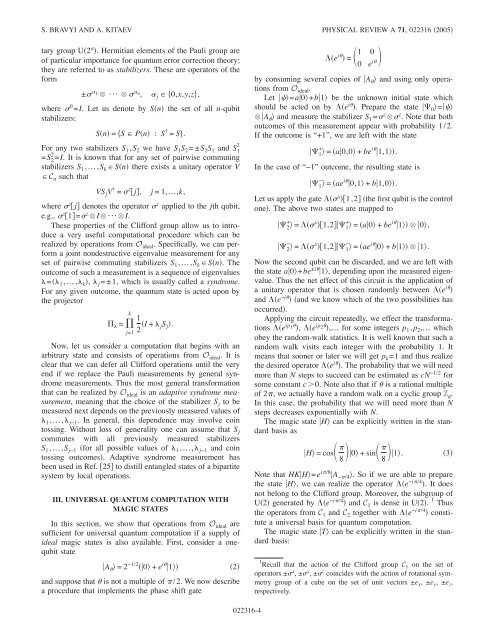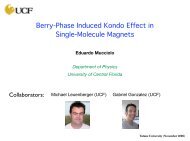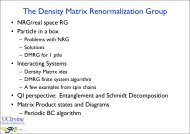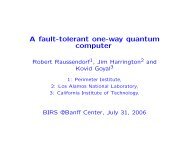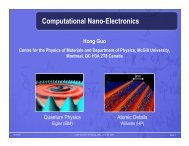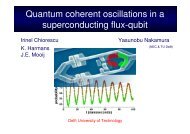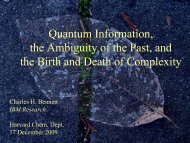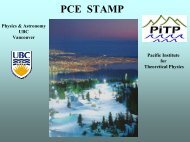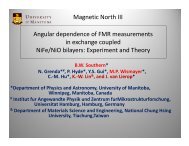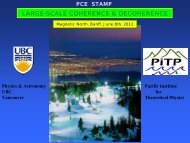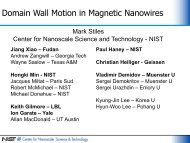Robert Raussendorf Statement and Readings - Pacific Institute of ...
Robert Raussendorf Statement and Readings - Pacific Institute of ...
Robert Raussendorf Statement and Readings - Pacific Institute of ...
Create successful ePaper yourself
Turn your PDF publications into a flip-book with our unique Google optimized e-Paper software.
S. BRAVYI AND A. KITAEV PHYSICAL REVIEW A 71, 022316 2005tary group U2 n . Hermitian elements <strong>of</strong> the Pauli group are<strong>of</strong> particular importance for quantum error correction theory;they are referred to as stabilizers. These are operators <strong>of</strong> theform± 1 ¯ n, j 0,x,y,z,where 0 =I. Let us denote by Sn the set <strong>of</strong> all n-qubitstabilizers:Sn = S Pn : S † = S.For any two stabilizers S 1 ,S 2 we have S 1 S 2 = ±S 2 S 1 <strong>and</strong> S 12=S 2 2 =I. It is known that for any set <strong>of</strong> pairwise commutingstabilizers S 1 ,…,S k Sn there exists a unitary operator VC n such thatVS j V † = z j,j = 1,…,k,where z j denotes the operator z applied to the jth qubit,e.g., z 1= z I ¯ I.These properties <strong>of</strong> the Clifford group allow us to introducea very useful computational procedure which can berealized by operations from O ideal . Specifically, we can performa joint nondestructive eigenvalue measurement for anyset <strong>of</strong> pairwise commuting stabilizers S 1 ,…,S k Sn. Theoutcome <strong>of</strong> such a measurement is a sequence <strong>of</strong> eigenvalues= 1 ,…, k , j = ±1, which is usually called a syndrome.For any given outcome, the quantum state is acted upon bythe projectork1 = j=1 2 I + jS j .Now, let us consider a computation that begins with anarbitrary state <strong>and</strong> consists <strong>of</strong> operations from O ideal . It isclear that we can defer all Clifford operations until the veryend if we replace the Pauli measurements by general syndromemeasurements. Thus the most general transformationthat can be realized by O ideal is an adaptive syndrome measurement,meaning that the choice <strong>of</strong> the stabilizer S j to bemeasured next depends on the previously measured values <strong>of</strong> 1 ,…, j−1 . In general, this dependence may involve cointossing. Without loss <strong>of</strong> generality one can assume that S jcommutes with all previously measured stabilizersS 1 ,…,S j−1 for all possible values <strong>of</strong> 1 ,…, j−1 <strong>and</strong> cointossing outcomes. Adaptive syndrome measurement hasbeen used in Ref. 25 to distill entangled states <strong>of</strong> a bipartitesystem by local operations.III. UNIVERSAL QUANTUM COMPUTATION WITHMAGIC STATESIn this section, we show that operations from O ideal aresufficient for universal quantum computation if a supply <strong>of</strong>ideal magic states is also available. First, consider a onequbitstateA = 2 −1/2 0 + e i 1<strong>and</strong> suppose that is not a multiple <strong>of</strong> /2. We now describea procedure that implements the phase shift gate2022316-4e i = 1 00 e i by consuming several copies <strong>of</strong> A <strong>and</strong> using only operationsfrom O ideal .Let =a0+b1 be the unknown initial state whichshould be acted on by e i . Prepare the state 0 = A <strong>and</strong> measure the stabilizer S 1 = z z . Note that bothoutcomes <strong>of</strong> this measurement appear with probability 1/2.If the outcome is “+1”, we are left with the state 1 + = a0,0 + be i 1,1.In the case <strong>of</strong> “−1” outcome, the resulting state is 1 − = ae i 0,1 + b1,0.Let us apply the gate x 1,2 the first qubit is the controlone. The above two states are mapped to 2 + = x 1,2 1 + = a0 + be i 1 0, 2 − = x 1,2 1 − = ae i 0 + b1 1.Now the second qubit can be discarded, <strong>and</strong> we are left withthe state a0+be ±i 1, depending upon the measured eigenvalue.Thus the net effect <strong>of</strong> this circuit is the application <strong>of</strong>a unitary operator that is chosen r<strong>and</strong>omly between e i <strong>and</strong> e −i <strong>and</strong> we know which <strong>of</strong> the two possibilities hasoccurred.Applying the circuit repeatedly, we effect the transformationse ip 1 , e ip 2 ,… for some integers p 1 , p 2 ,… whichobey the r<strong>and</strong>om-walk statistics. It is well known that such ar<strong>and</strong>om walk visits each integer with the probability 1. Itmeans that sooner or later we will get p k =1 <strong>and</strong> thus realizethe desired operator e i . The probability that we will needmore than N steps to succeed can be estimated as cN −1/2 forsome constant c0. Note also that if is a rational multiple<strong>of</strong> 2, we actually have a r<strong>and</strong>om walk on a cyclic group Z q .In this case, the probability that we will need more than Nsteps decreases exponentially with N.The magic state H can be explicitly written in the st<strong>and</strong>ardbasis asH = cos 80 + sin 81.Note that HKH=e i/8 A −/4 . So if we are able to preparethe state H, we can realize the operator e −i/4 . It doesnot belong to the Clifford group. Moreover, the subgroup <strong>of</strong>U2 generated by e −i/4 <strong>and</strong> C 1 is dense in U2. 1 Thusthe operators from C 1 <strong>and</strong> C 2 together with e −i/4 constitutea universal basis for quantum computation.The magic state T can be explicitly written in the st<strong>and</strong>ardbasis:1 Recall that the action <strong>of</strong> the Clifford group C 1 on the set <strong>of</strong>operators ± x , ± y , ± z coincides with the action <strong>of</strong> rotational symmetrygroup <strong>of</strong> a cube on the set <strong>of</strong> unit vectors ±e x , ±e y , ±e z ,respectively.3


